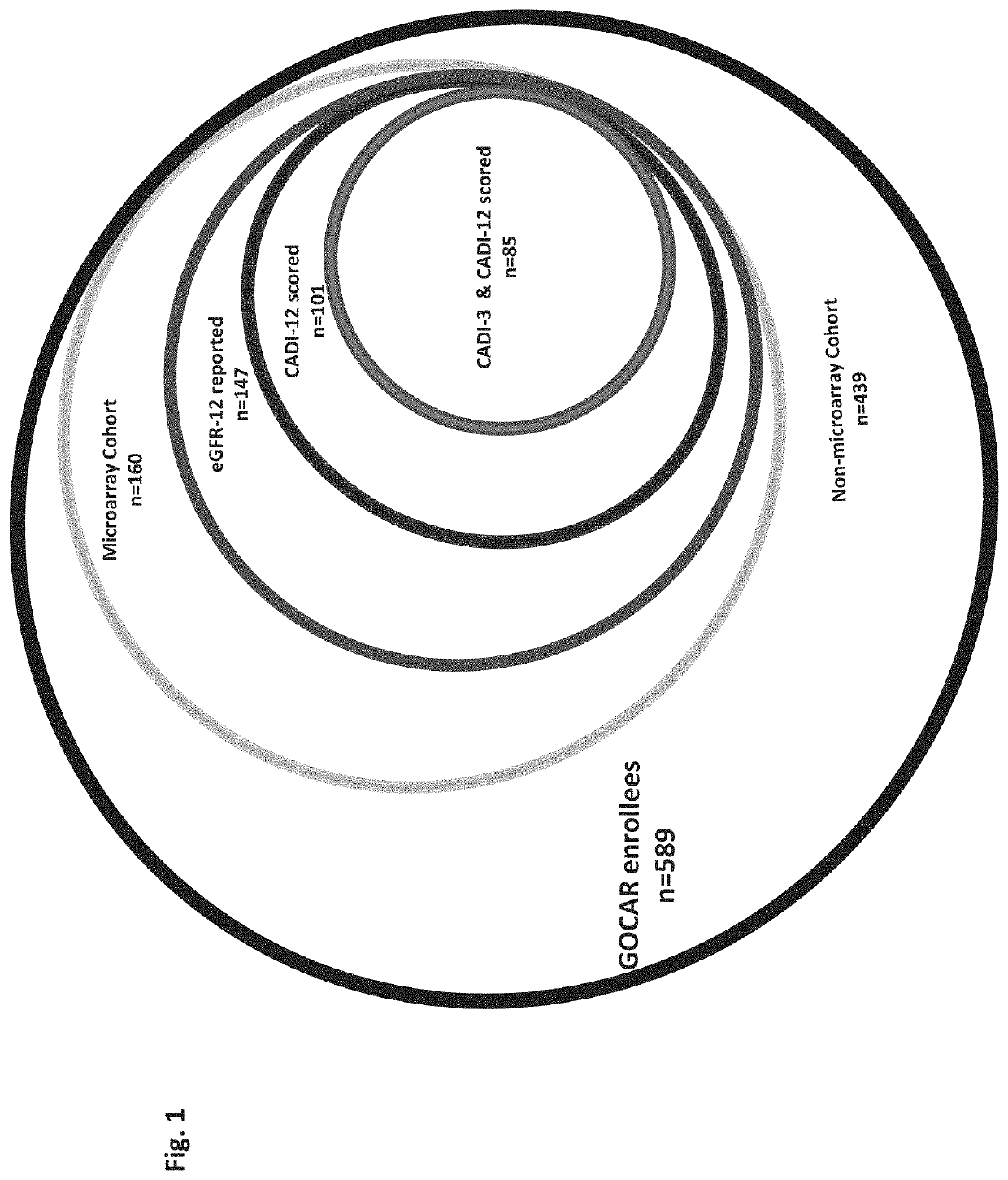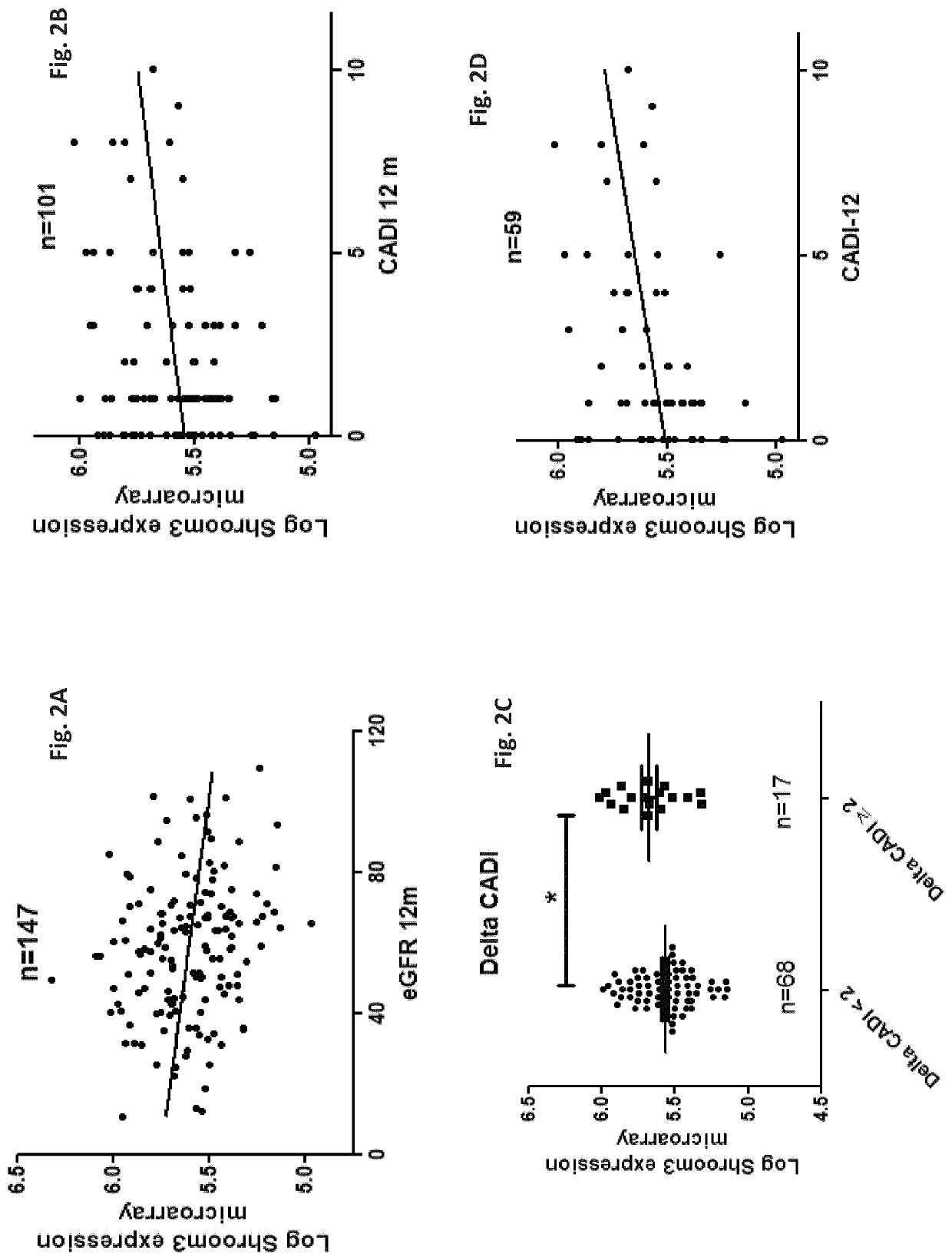Use of shroom3 in chronic kidney disease and chronic allograft nephropathy
a technology of allograft nephropathy and kidney disease, which is applied in the direction of drugs, instruments, immunological disorders, etc., can solve the problems of increasing the risk of cardiovascular disease and all-cause mortality, and no effective anti-fibrotic therapy to prevent the progression of ckd, so as to reduce renal function and increase the expression of shroom3
- Summary
- Abstract
- Description
- Claims
- Application Information
AI Technical Summary
Benefits of technology
Problems solved by technology
Method used
Image
Examples
example 1
[0060]SHROOM3 is Upregulated and Associated with Progression of CAN
[0061]To identify genes that could potentially contribute to the development of CAN we performed an interim analysis for the first 66 subjects of the cohort who had the gene expression microarray data from the 3-month allograft biopsy as well as eGFR_12 and CADI_12. A list of candidate genes involved in CAN progression—that is, genes whose expression in the 3-month allograft sample correlated with a low eGFR_12 as well as a high CADI_12—were identified and ranked. SHROOM3 was among the top-ranked genes on the list (Table 3). Since the interim analysis, we have collected and analyzed additional samples. At the time of preparation of the instant application, 3-month allograft gene expression profiles have been performed on 160 allografts and of which 12-month eGFR (eGFR 12) was available in 147 subjects and 12-month CADI (CADI_12) was available in 101 subjects (FIG. 1). When we reexamined the correlation of 3-month all...
example 2
[0062]Association of SHROOM3 and CAN Progression Exists in Caucasian-Donor Allografts
[0063]Since a genetic variant of SHROOM3 (SNP variant rs17319721) is associated with CKD when studied in predominantly Caucasian cohorts [Kottgen A, 2009], we sought to determine whether the relationship observed between SHROOM3 and CAN followed a racial predilection. Of the 147 allografts with available eGFR_12, 109 were from Caucasian donors and their SHROOM3 expression was inversely correlated with eGFR_12 (r=−0.2712, P=5; n=7) (P=0.03, FIG. 3C).
example 3
[0064]A Non-Coding SHROOM3 Variant in the Donor is Associated with Increased SHROOM3 Expression
[0065]The A-allele (minor allele) of a non-coding SHROOM3 SNP at rs17319721 has been strongly linked to chronic kidney disease by eGFR-creatinine [Kottgen A, 2009; Boger C, 2011]. We performed targeted SNP genotyping for the rs17319721 variant in 540 allograft recipients and 468 donor samples. Allelic prevalence of the risk allele (A) was 36.66% among recipients and 40.02% among donors. In both recipients and donors, we observed that the prevalence of the risk allele was significantly higher in Caucasians compared to non-Caucasians (P<0.0001) (FIG. 6A). Since a higher SHROOM3 expression correlates with CAN progression and the risk allele of SHROOM3 is associated with CKD in predominantly Caucasian cohorts, here we examined whether allograft SHROOM3 expression correlated with the presence of the risk allele. Of the 160 allografts for which SHROOM3 expression was available, targeted SNP geno...
PUM
| Property | Measurement | Unit |
|---|---|---|
| Real Time Polymerase Chain Reaction | aaaaa | aaaaa |
| size | aaaaa | aaaaa |
| time | aaaaa | aaaaa |
Abstract
Description
Claims
Application Information
 Login to View More
Login to View More - R&D
- Intellectual Property
- Life Sciences
- Materials
- Tech Scout
- Unparalleled Data Quality
- Higher Quality Content
- 60% Fewer Hallucinations
Browse by: Latest US Patents, China's latest patents, Technical Efficacy Thesaurus, Application Domain, Technology Topic, Popular Technical Reports.
© 2025 PatSnap. All rights reserved.Legal|Privacy policy|Modern Slavery Act Transparency Statement|Sitemap|About US| Contact US: help@patsnap.com



